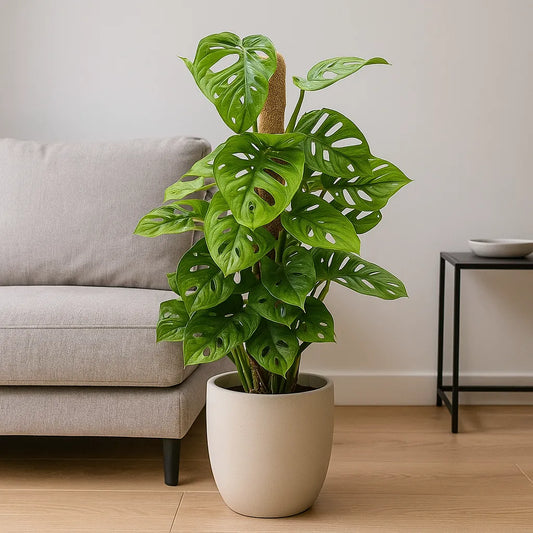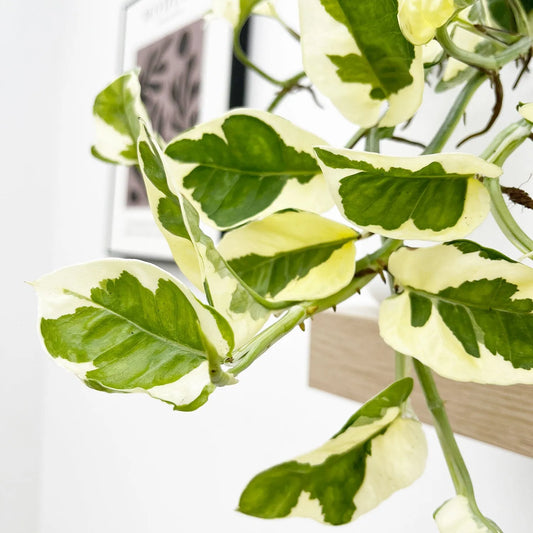Why is my Ficus dropping leaves and how to solve it
The Ficus is a beautiful tropical houseplant that is a delight for many house plant growers across the UK. Not only is the Ficus an air purifying plant, but they come in a variety of colours and sizes that will delight anyone in your home.
But, even though the Ficus is an easy to look after houseplant it has a habit of dropping its leaves. This is often a scary occurrence for both novice and expert house plant growers who may avoid this wonderful plant because they think it is too difficult to look after. However, nothing could be further from the truth, the Ficus is an adaptive plant that will do everything it can to maintain energy, and often this means shedding it’s foliage. In this guide we will take you through the most common reasons for your Ficus shedding its leaves, and how to solve them.
Inconsistent watering
The main cause of leaf drop in a Ficus is inconsistent watering. In the wild, this plant lives in regions with a pronounced wet/dry season so it has adapted to this by going into a semi-dormant state in the dry season. Part of this includes shedding its leaves.
When you water your Ficus you are replicating this natural cycle and if you go longer than usual without watering the plant you will trigger your Ficus to drop its leaves. To get around this you should water your plant little and often when the top of the soil has begun to dry. You can also add elements like vermiculite to the soil to help regulate the moisture levels.
Under watering
If your Ficus doesn’t receive enough water it will begin to drop its leaves. Like we said above, when the potting medium becomes dry the plant begins to prepare for a dry season. The Ficus responds to dry soil by dropping its leaves so it can conserve energy. You should never let the top inch of your Ficus’s soil dry out, but if you do water well and the plant will bounce back quickly.
Adopt a consistent watering schedule
Water your ficus regularly, allowing the top inch of soil to dry out between watering. Ensure your pot has drainage holes to prevent waterlogging and root rot.
Root rot
Over Watering a Ficus is just as dangerous as under watering it. The Ficus has delicate roots that do not react well to sitting in standing water and will quickly develop root rot in these conditions. The first signs of root rot will appear under the soil as the roots become brown and soft to the touch.
However, because root rot starts under the soil it can be hard to detect and the first signs you will most likely see is a yellowing and dropping of the leaves. If your Ficus leaves begin to yellow you should check the roots for issues immediately. To check for root rot in a Ficus, gently lift the plant from the soil so you can see the top of the roots. If they are white and firm then your leaves are drooping for another reason. But unhealthy Ficus roots will be brown, soft to the touch and have a rotten smell. If you find that this is the case you need to act quickly.
The best way to save a Ficus from root rot is to repot it in new soil quickly. Remove the plant from the pot and trim any diseased roots if possible. You should then quickly repot into new well-draining soil. Water the new soil well and leave the plant to recover.
Seasonal changes
As the seasons change your Ficus will react to the changes in light, temperature and humidity by dropping its leaves. This is a normal part of the plant's life cycle and can be averted by continuing to water the plant, heating the home and misting the plant to maintain humidity. However, if the plant does go on to drop its leaves then you don’t have to worry as they will grow back in the spring.
Not enough light
The Ficus is a tropical houseplant that is native to sunny places across the world. If your Ficus isn’t getting enough exposure to sunlight then the leaves will begin to brown and drop in order to conserve energy. Your Ficus will thrive in bright, indirect light throughout the day. It can handle some direct light, but it is a lot less tolerant to low light levels.
Provide optimal lighting
If you see the leaves beginning to react you should move your Ficus to a sunnier location. You should also make sure that your Ficus is receiving light equally by rotating the pot by ninety degrees once a week. This will ensure constant coverage across the plant which stops parts of it dropping whilst others don't.
Draughty location
Like many other houseplants the Ficus doesn’t like cold draughts. These can come from badly sealed windows and air vents. Tropical plants like the Ficus are especially sensitive to cold draughts because they can drop the room temperature and make the plant think it is winter, making it go dormant and drop its leaves. To avoid this, the easiest thing you can do is move a ficus from a draughty location. If this isn’t possible then you can buy draught excluders to help limit their effect.
Maintain a stable location
Keep your ficus plant in a stable environment with consistent temperature and light conditions. Avoid draughts, radiators, or areas prone to sudden temperature changes.
Low humidity levels
Ficus plants tend to thrive in high humidity. Dry indoor air that's more common inside your home, especially during winter when you've got the heating on, can cause your plant to lose leaves as it struggles to get moisture.
Increase humidity levels
Boost the humidity around your plant by misting the leaves, using a humidifier, or placing a pebble tray with water near your plant. if you have a few plants, grouping them together can also provide a more humid environment.
Pests and diseases
Pests such as spider mites, scale, and mealybugs, along with fungal infections, can weaken your ficus plant. Infestations typically cause yellowing leaves before they eventually drop.
Manage pests and diseases
Regularly inspect your ficus for any signs of pests. If you find any treat your plant with insecticidal soap or neem oil.
Nutrient deficiencies
A lack of essential nurtrients can cause poor health in your ficus, leading to leaf drop. Ensuring your plant receives adequate nutrition is crucial for its overall health.
Provide balanced fertilisation
Feed your ficus with a balanced houseplant feed every four to six weeks during the growing season (spring and summer). Reduce feeding in autumn and winter when growth slows down.
Seeing your ficus plant dropping its leaves can be distressing, but with the right care and attention, you can rejuvenate your plant. Understanding the specific needs of your ficus and promptly addressing any issues will ensure it remains healthy and vibrant.
By following these guidelines, your ficus will flourish, adding beauty and greenery to your home all year round.











1 comment
I have a large ficus with long leggy branches that have many lovely leaves at the end of each branch….it’s such a shame it looks so bare in the centre around only main branch from which the smaller leggy branches have grown from…the long leggy ones. HELP !!
Leave a comment
Please note, comments need to be approved before they are published.